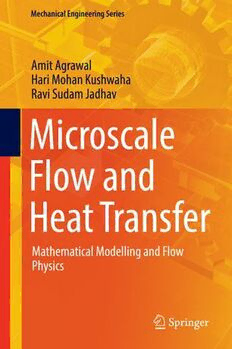Table Of ContentMechanical Engineering Series
Amit Agrawal
Hari Mohan Kushwaha
Ravi Sudam Jadhav
Microscale
Flow and
Heat Transfer
Mathematical Modelling and Flow
Physics
Mechanical Engineering Series
SeriesEditor
FrancisA.Kulacki
DepartmentofMechanicalEngineering
UniversityofMinnesota
Minneapolis,Minnesota,USA
The Mechanical Engineering Series presents advanced level treatment of topics
on the cutting edge of mechanical engineering. Designed for use by students,
researchers and practicing engineers, the series presents modern developments
in mechanical engineering and its innovative applications in applied mechanics,
bioengineering,dynamicsystemsandcontrol,energy,energyconversionandenergy
systems,fluidmechanicsandfluidmachinery,heatandmasstransfer,manufacturing
science and technology, mechanical design, mechanics of materials, micro- and
nano-science technology, thermal physics, tribology, and vibration and acoustics.
The series features graduate-level texts, professional books, and research mono-
graphsinkeyengineeringscienceconcentrations.
Moreinformationaboutthisseriesathttp://www.springer.com/series/1161
Amit Agrawal • Hari Mohan Kushwaha
Ravi Sudam Jadhav
Microscale Flow and Heat
Transfer
Mathematical Modelling and Flow Physics
123
AmitAgrawal HariMohanKushwaha
DepartmentofMechanicalEngineering DepartmentofMechanicalEngineering
IndianInstituteofTechnology,Bombay IndianInstituteofTechnology,Bombay
Mumbai,Maharashtra,India Mumbai,Maharashtra,India
RaviSudamJadhav
DepartmentofMechanicalEngineering
IndianInstituteofTechnology,Bombay
Mumbai,Maharashtra,India
ISSN0941-5122 ISSN2192-063X (electronic)
MechanicalEngineeringSeries
ISBN978-3-030-10661-4 ISBN978-3-030-10662-1 (eBook)
https://doi.org/10.1007/978-3-030-10662-1
LibraryofCongressControlNumber:2019932162
©SpringerNatureSwitzerlandAG2020
Thisworkissubjecttocopyright.AllrightsarereservedbythePublisher,whetherthewholeorpartof
thematerialisconcerned,specificallytherightsoftranslation,reprinting,reuseofillustrations,recitation,
broadcasting,reproductiononmicrofilmsorinanyotherphysicalway,andtransmissionorinformation
storageandretrieval,electronicadaptation,computersoftware,orbysimilarordissimilarmethodology
nowknownorhereafterdeveloped.
Theuseofgeneraldescriptivenames,registerednames,trademarks,servicemarks,etc.inthispublication
doesnotimply,evenintheabsenceofaspecificstatement,thatsuchnamesareexemptfromtherelevant
protectivelawsandregulationsandthereforefreeforgeneraluse.
Thepublisher,theauthors,andtheeditorsaresafetoassumethattheadviceandinformationinthisbook
arebelievedtobetrueandaccurateatthedateofpublication.Neitherthepublishernortheauthorsor
theeditorsgiveawarranty,expressorimplied,withrespecttothematerialcontainedhereinorforany
errorsoromissionsthatmayhavebeenmade.Thepublisherremainsneutralwithregardtojurisdictional
claimsinpublishedmapsandinstitutionalaffiliations.
ThisSpringerimprintispublishedbytheregisteredcompanySpringerNatureSwitzerlandAG.
Theregisteredcompanyaddressis:Gewerbestrasse11,6330Cham,Switzerland
Thisbookisdedicatedto
pastandcurrentstudentsof“RarefiedGas
Dynamics”and“Microfluidics”
laboratories,IITBombay,
and
toourfamilies.
Preface
This book has been written with the objective of making the readers familiar with
the exciting developments on gaseous slip flow and heat transfer in microchannel.
A large amount of work is being currently undertaken worldwide in these areas,
with numerous potential applications. The subject is therefore topical and also
particularly significant as it leads to the question about the validity of the Navier-
Stokes equations, which is usually considered sacrosanct. It obviously leads to a
subsequentquestion:iftheNavier-Stokesequationsarethemselvesnotvalid,then
how do we model the flow and heat transfer? Although the answer to this last
question is still not clear, it is important for the fluids and thermal community
to first appreciate the limitations of the continuum approach (which leads to the
Navier-Stokes equations), to better appreciate the ongoing search for the “beyond
Navier-Stokes equations,” and to test some of the available equations for their
accuracy,beforethelargerobjectiveoffindingbeyondtheNavier-Stokesequations
canbepracticallymet.
Thebookisthereforeorganizedintwoparts:thefirstpartisonthegaseousslip
flow and heat transfer in microchannel (Chaps. 2 and 3). In the second part, we
examinebeyondtheNavier-Stokesequations(Chaps.5–7).Chapter1summarizes
the characteristics of microscale flows and provides an introduction to the various
modelling approaches available. Chapter 4 is a transition chapter between the two
parts, where it is shown that simple extensions of the Navier-Stokes equations are
notadequate.Recognizingthatonlyanalyticaltoolwillnotbeadequateforstudying
flowsintheslipandtransitionregimes,abriefoverviewtorelevantnumericaland
experimental techniques is provided in Chap. 8. Finally, Chap. 9 summarizes our
currentunderstandingandprovidessuggestionsforfutureresearchinthissubject.
The Knudsen number is the most important parameter, and several known
solutionswithKnudsennumberasanadditionalparameterarecompiledinthefirst
partofthebook.InterestingobservationsonKnudsenminimaandflowseparation
are presented. However, it should become apparent that our understanding of heat
transfer at the microscale is not that sound, as several additional effects such as
axial conduction, pressure work, conduction in the substrate, viscous dissipation,
etc. coexist, but it is virtually not possible to treat all these effects together and
vii
viii Preface
obtainananalyticalsolutionforeventhesimplestproblems.Onlyfewexperimental
and direct simulationMonte Carlo(DSMC) data exist,and they do notagree well
withthatobtainedfromalternativeapproaches.
A good portion of the second part of the book is devoted to deriving and
understandingtheBurnettandGradequations.Thesetwosetsofequationsformthe
most important “beyond the Navier-Stokes” equations and are generally referred
to as “higher-order continuum transport equations.” The study of these equations
is important for further development of the subject, as they involve several novel
concepts and represent important breakthroughs in the subject. The derivation of
these equations has not often been repeated, and it is expected that the stepwise
derivationpresentedherewillinvokewidereadership.Specialefforthasbeenmade
to make the text readable through the insertion of a large number of figures. The
hopeisthatwiththehelpofthisbook,itshouldnowbepossibletoderivetheBurnett
andGradequationsinagraduateclass.Afewproblemsaresolvedtoillustratethe
typeofsolutionobtainedfromtheseequations.Inthederivationofsomesolutions
presentedhere,someminorerrorintheoriginalsourcewasnoticedwhichhasbeen
correctedhere.
Thefirstpartofthebook(Chaps.1–3alongwithChaps.8and9)shouldappeal
toreadersinterestedinunderstandingfundamentalaspectsofmicroscaleflowsand
heattransfer,whilethesecondpart(Chaps.4–7)isprimarilyforslightlyadvanced
readersinterestedinunderstandingequationsbeyondtheNavier-Stokesequations.
Mumbai,India AmitAgrawal
Mumbai,India HariMohanKushwaha
Mumbai,India RaviSudamJadhav
September2018
Acknowledgments
Wearegratefultoallthestudentswhohaveworkedinthe“RarefiedGasDynamics”
and“Microfluidics”laboratoriesatIITBombay,includingthosewhowereinvolved
inpurelytheoreticalornumericalaspectsoftheproblem.Itistheywhoslowlyand
patientlyuncoveredthevariousfinepointsofthesubject,whichfinallyculminated
intheformofthisbook.WearealsogratefultoProf.K.Muralidhar(IITKanpur)
and Prof. F. Kulacki (University of Minnesota), the editors of this series, for first
placing their trust in us for writing this book and then patiently waiting for it
while we went past several deadlines. The book would not have resulted without
thecoaxingofProf.Muralidhartowriteonthissubject.Whilepreparingthebook,
wegainedfromthecommentsofProf.AtulSharma(IITBombay).
FundingforthislineofinvestigationhasbeenprovidedbytheIndianInstituteof
TechnologyBombay(IITB),IndianSpaceResearchOrganisation(ISRO),Depart-
mentofScienceandTechnology(DST),andrecentlybytheDepartmentofAtomic
Energy (DAE) under its prestigious scheme—DAE-SRC Outstanding Investigator
Award,awardedtothefirstauthor.
ix
Contents
1 IntroductiontoMicroscaleFlowsandMathematicalModelling....... 1
1.1 Introduction............................................................ 2
1.2 ApplicationsofMicroscaleFlows .................................... 3
1.2.1 CoolingofElectronicDevices ............................... 4
1.2.2 Micro-nozzlesandMicro-thruster ........................... 4
1.2.3 BreathAnalyser............................................... 6
1.2.4 MicrodeviceforConductingBloodTest..................... 6
1.3 ClassificationofFlowRegimes....................................... 8
1.4 CharacteristicsofMicroscaleFlows.................................. 9
1.4.1 Rarefaction.................................................... 9
1.4.2 Compressibility ............................................... 10
1.4.3 ThermalCreep ................................................ 11
1.4.4 ViscousDissipation........................................... 12
1.4.5 PropertyVariation............................................. 13
1.4.6 AxialConduction ............................................. 14
1.4.7 ConjugateHeatTransfer...................................... 14
1.5 MathematicalModellingofMicroscaleFlows....................... 15
1.5.1 TheNavier–StokesEquations................................ 16
1.5.2 LimitationsofConventionalEquationsandBoundary
Conditions..................................................... 16
1.5.3 ApproachtoModellingMicroscaleFlows................... 18
1.6 RelevanceandScopeoftheBook .................................... 21
2 MicroscaleFlows............................................................. 25
2.1 Introduction............................................................ 25
2.2 GoverningEquationsforFluidFlow ................................. 26
2.2.1 TensorialForm................................................ 26
2.2.2 ConstitutiveRelations ........................................ 28
2.2.3 CompressibleNavier–StokesEquations..................... 30
2.2.4 IncompressibleNavier–StokesEquations ................... 31
xi

